Reflective Essay on NMBA Code of Conduct and Nursing Practice
VerifiedAdded on 2022/10/19
|17
|4504
|470
Essay
AI Summary
This reflective essay explores the NMBA Code of Conduct within the context of Australian nursing practice. It utilizes the Gibbs reflective cycle to analyze a critical incident involving a nurse's breach of professional conduct, specifically addressing issues of patient care and adherence to ethical standards. The essay includes a detailed description of the incident, the nurse's feelings, and an evaluation of the situation, followed by an analysis of the learning outcomes and a conclusion outlining an action plan for future scenarios. Furthermore, the essay applies evidence from NMBA guidelines and standards, and includes a case study analysis to distinguish implications and interventions. The aim is to highlight the importance of the NMBA standards in ensuring quality patient care and maintaining professional integrity, offering insights into how nurses can avoid similar breaches of conduct and improve their practice.
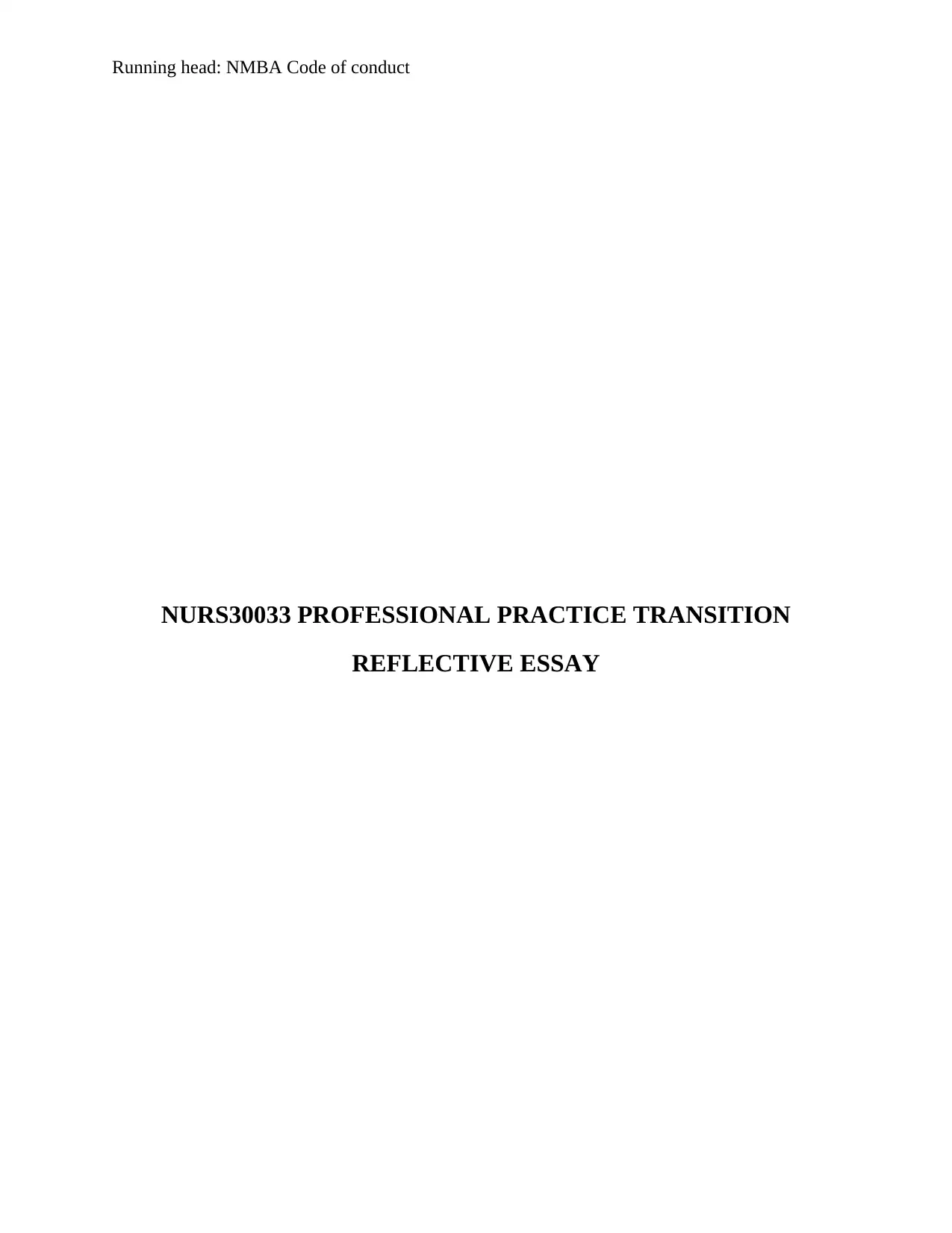
Running head: NMBA Code of conduct
NURS30033 PROFESSIONAL PRACTICE TRANSITION
REFLECTIVE ESSAY
NURS30033 PROFESSIONAL PRACTICE TRANSITION
REFLECTIVE ESSAY
Paraphrase This Document
Need a fresh take? Get an instant paraphrase of this document with our AI Paraphraser
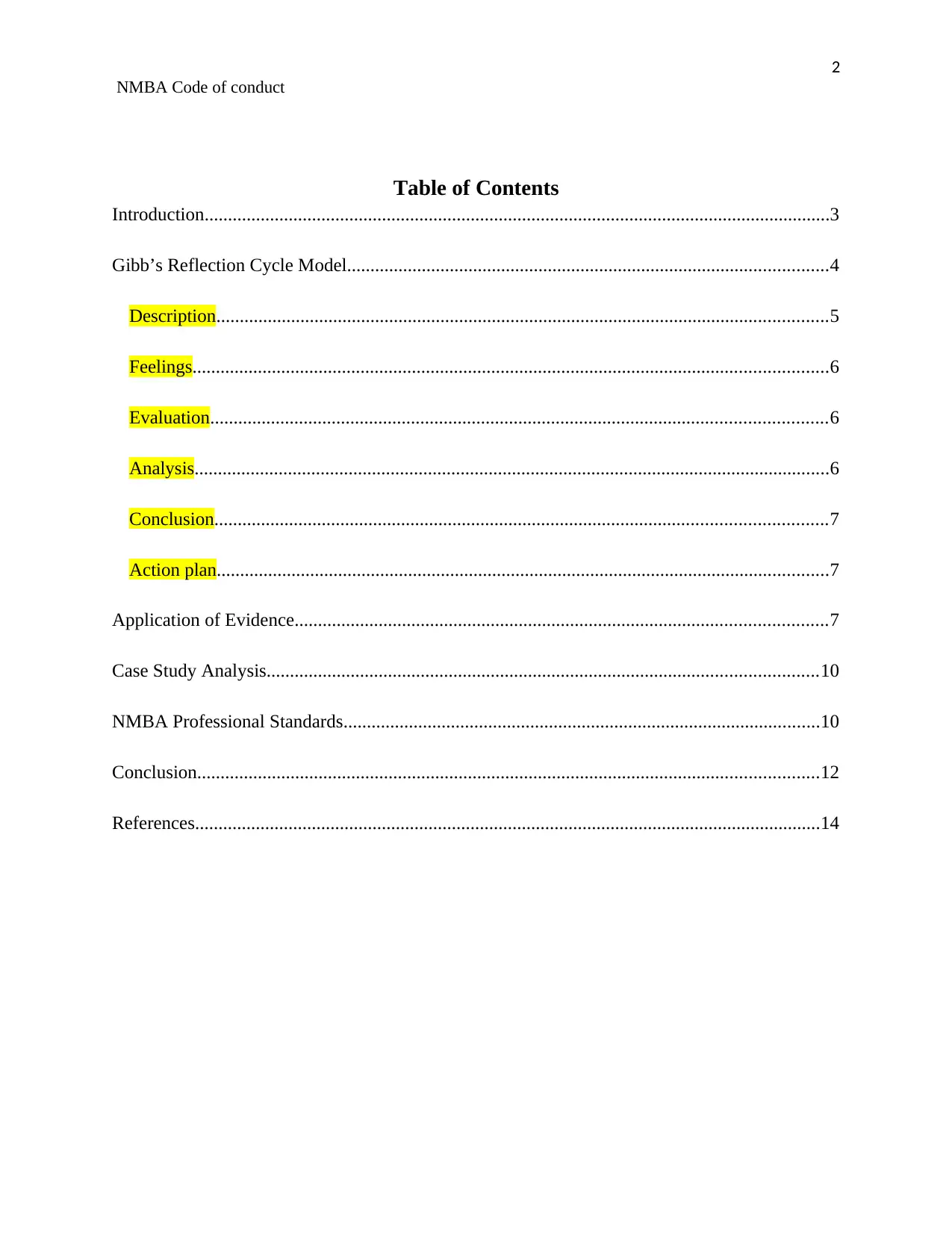
2
NMBA Code of conduct
Table of Contents
Introduction......................................................................................................................................3
Gibb’s Reflection Cycle Model.......................................................................................................4
Description...................................................................................................................................5
Feelings........................................................................................................................................6
Evaluation....................................................................................................................................6
Analysis........................................................................................................................................6
Conclusion...................................................................................................................................7
Action plan...................................................................................................................................7
Application of Evidence..................................................................................................................7
Case Study Analysis......................................................................................................................10
NMBA Professional Standards......................................................................................................10
Conclusion.....................................................................................................................................12
References......................................................................................................................................14
NMBA Code of conduct
Table of Contents
Introduction......................................................................................................................................3
Gibb’s Reflection Cycle Model.......................................................................................................4
Description...................................................................................................................................5
Feelings........................................................................................................................................6
Evaluation....................................................................................................................................6
Analysis........................................................................................................................................6
Conclusion...................................................................................................................................7
Action plan...................................................................................................................................7
Application of Evidence..................................................................................................................7
Case Study Analysis......................................................................................................................10
NMBA Professional Standards......................................................................................................10
Conclusion.....................................................................................................................................12
References......................................................................................................................................14
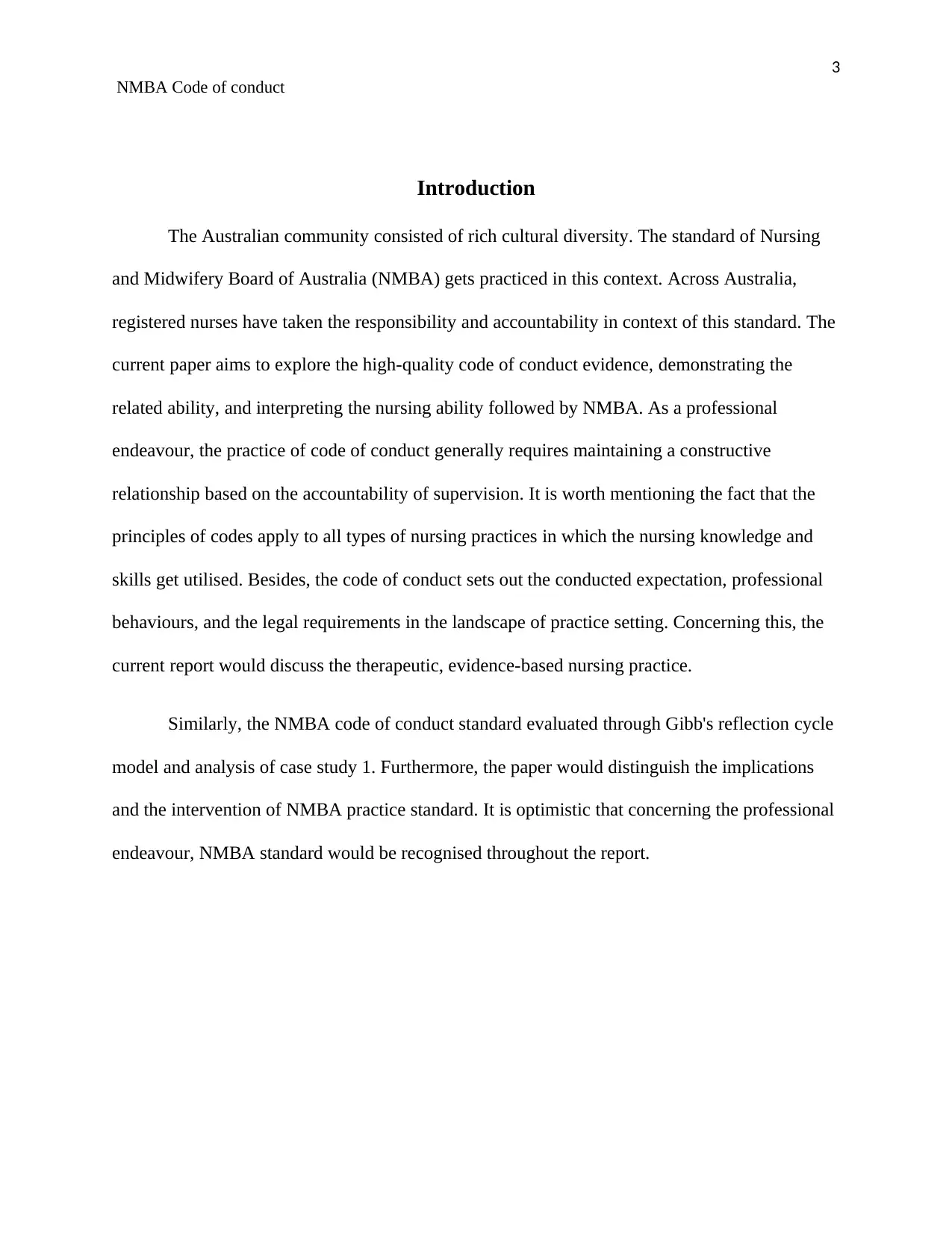
3
NMBA Code of conduct
Introduction
The Australian community consisted of rich cultural diversity. The standard of Nursing
and Midwifery Board of Australia (NMBA) gets practiced in this context. Across Australia,
registered nurses have taken the responsibility and accountability in context of this standard. The
current paper aims to explore the high-quality code of conduct evidence, demonstrating the
related ability, and interpreting the nursing ability followed by NMBA. As a professional
endeavour, the practice of code of conduct generally requires maintaining a constructive
relationship based on the accountability of supervision. It is worth mentioning the fact that the
principles of codes apply to all types of nursing practices in which the nursing knowledge and
skills get utilised. Besides, the code of conduct sets out the conducted expectation, professional
behaviours, and the legal requirements in the landscape of practice setting. Concerning this, the
current report would discuss the therapeutic, evidence-based nursing practice.
Similarly, the NMBA code of conduct standard evaluated through Gibb's reflection cycle
model and analysis of case study 1. Furthermore, the paper would distinguish the implications
and the intervention of NMBA practice standard. It is optimistic that concerning the professional
endeavour, NMBA standard would be recognised throughout the report.
NMBA Code of conduct
Introduction
The Australian community consisted of rich cultural diversity. The standard of Nursing
and Midwifery Board of Australia (NMBA) gets practiced in this context. Across Australia,
registered nurses have taken the responsibility and accountability in context of this standard. The
current paper aims to explore the high-quality code of conduct evidence, demonstrating the
related ability, and interpreting the nursing ability followed by NMBA. As a professional
endeavour, the practice of code of conduct generally requires maintaining a constructive
relationship based on the accountability of supervision. It is worth mentioning the fact that the
principles of codes apply to all types of nursing practices in which the nursing knowledge and
skills get utilised. Besides, the code of conduct sets out the conducted expectation, professional
behaviours, and the legal requirements in the landscape of practice setting. Concerning this, the
current report would discuss the therapeutic, evidence-based nursing practice.
Similarly, the NMBA code of conduct standard evaluated through Gibb's reflection cycle
model and analysis of case study 1. Furthermore, the paper would distinguish the implications
and the intervention of NMBA practice standard. It is optimistic that concerning the professional
endeavour, NMBA standard would be recognised throughout the report.
⊘ This is a preview!⊘
Do you want full access?
Subscribe today to unlock all pages.

Trusted by 1+ million students worldwide
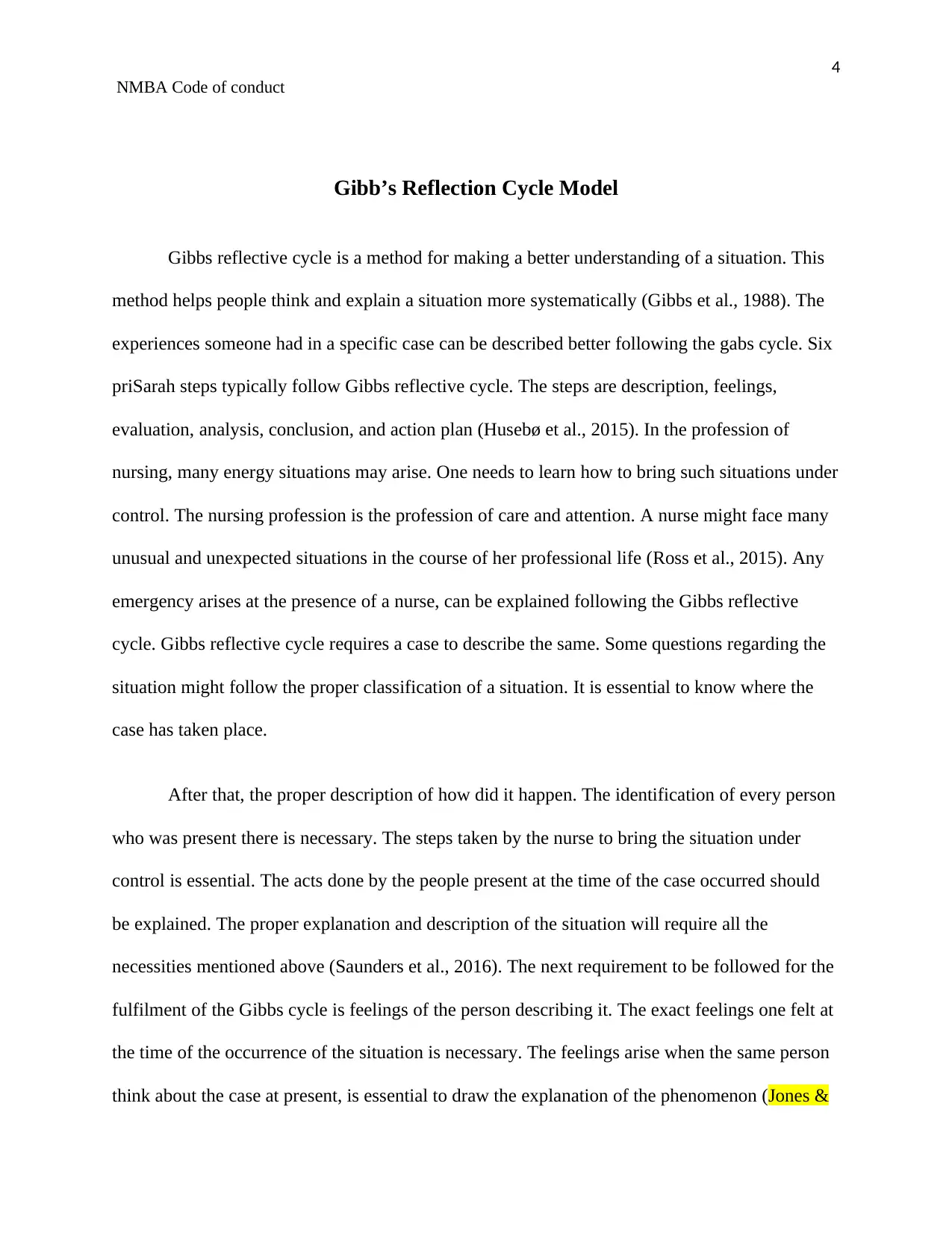
4
NMBA Code of conduct
Gibb’s Reflection Cycle Model
Gibbs reflective cycle is a method for making a better understanding of a situation. This
method helps people think and explain a situation more systematically (Gibbs et al., 1988). The
experiences someone had in a specific case can be described better following the gabs cycle. Six
priSarah steps typically follow Gibbs reflective cycle. The steps are description, feelings,
evaluation, analysis, conclusion, and action plan (Husebø et al., 2015). In the profession of
nursing, many energy situations may arise. One needs to learn how to bring such situations under
control. The nursing profession is the profession of care and attention. A nurse might face many
unusual and unexpected situations in the course of her professional life (Ross et al., 2015). Any
emergency arises at the presence of a nurse, can be explained following the Gibbs reflective
cycle. Gibbs reflective cycle requires a case to describe the same. Some questions regarding the
situation might follow the proper classification of a situation. It is essential to know where the
case has taken place.
After that, the proper description of how did it happen. The identification of every person
who was present there is necessary. The steps taken by the nurse to bring the situation under
control is essential. The acts done by the people present at the time of the case occurred should
be explained. The proper explanation and description of the situation will require all the
necessities mentioned above (Saunders et al., 2016). The next requirement to be followed for the
fulfilment of the Gibbs cycle is feelings of the person describing it. The exact feelings one felt at
the time of the occurrence of the situation is necessary. The feelings arise when the same person
think about the case at present, is essential to draw the explanation of the phenomenon (Jones &
NMBA Code of conduct
Gibb’s Reflection Cycle Model
Gibbs reflective cycle is a method for making a better understanding of a situation. This
method helps people think and explain a situation more systematically (Gibbs et al., 1988). The
experiences someone had in a specific case can be described better following the gabs cycle. Six
priSarah steps typically follow Gibbs reflective cycle. The steps are description, feelings,
evaluation, analysis, conclusion, and action plan (Husebø et al., 2015). In the profession of
nursing, many energy situations may arise. One needs to learn how to bring such situations under
control. The nursing profession is the profession of care and attention. A nurse might face many
unusual and unexpected situations in the course of her professional life (Ross et al., 2015). Any
emergency arises at the presence of a nurse, can be explained following the Gibbs reflective
cycle. Gibbs reflective cycle requires a case to describe the same. Some questions regarding the
situation might follow the proper classification of a situation. It is essential to know where the
case has taken place.
After that, the proper description of how did it happen. The identification of every person
who was present there is necessary. The steps taken by the nurse to bring the situation under
control is essential. The acts done by the people present at the time of the case occurred should
be explained. The proper explanation and description of the situation will require all the
necessities mentioned above (Saunders et al., 2016). The next requirement to be followed for the
fulfilment of the Gibbs cycle is feelings of the person describing it. The exact feelings one felt at
the time of the occurrence of the situation is necessary. The feelings arise when the same person
think about the case at present, is essential to draw the explanation of the phenomenon (Jones &
Paraphrase This Document
Need a fresh take? Get an instant paraphrase of this document with our AI Paraphraser
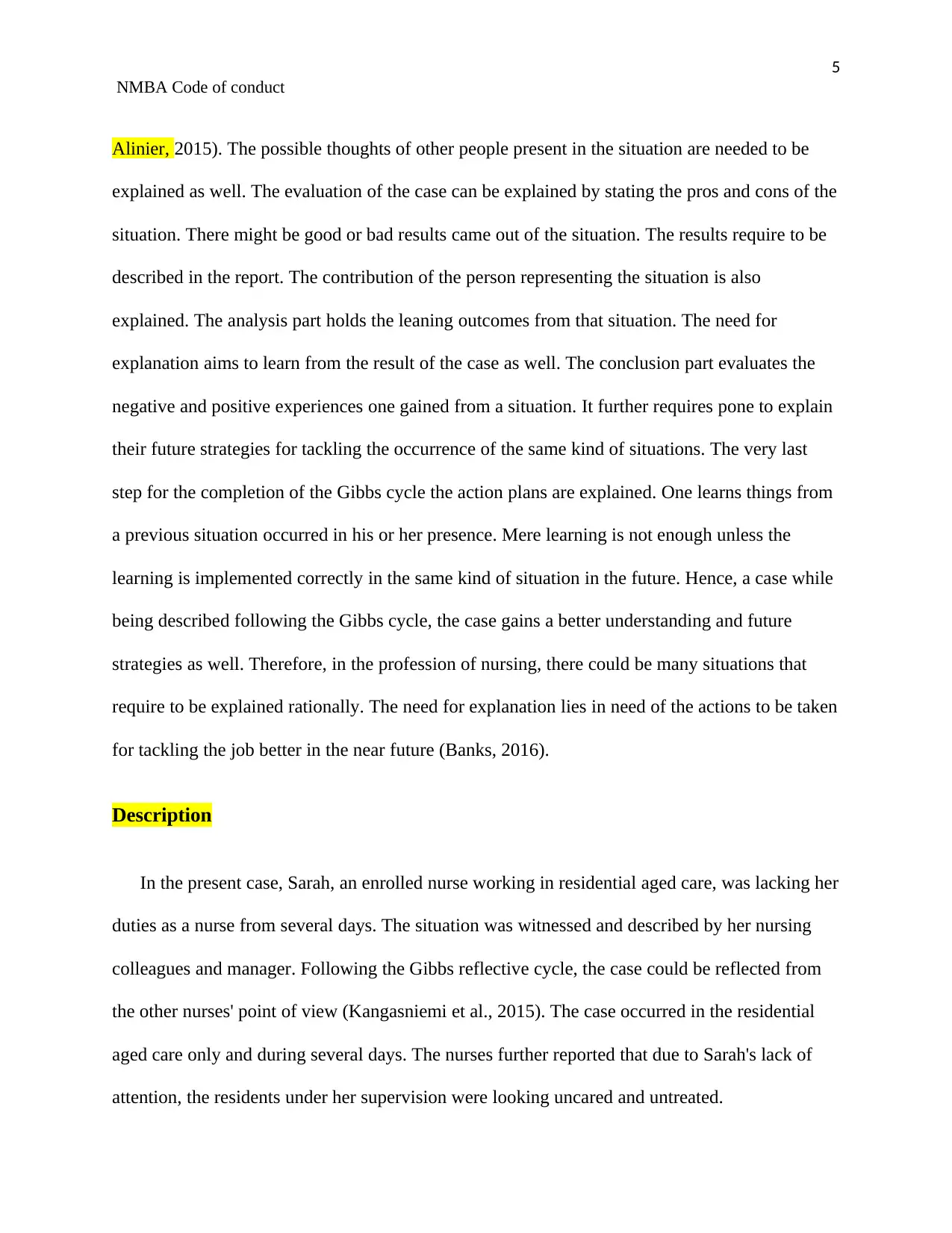
5
NMBA Code of conduct
Alinier, 2015). The possible thoughts of other people present in the situation are needed to be
explained as well. The evaluation of the case can be explained by stating the pros and cons of the
situation. There might be good or bad results came out of the situation. The results require to be
described in the report. The contribution of the person representing the situation is also
explained. The analysis part holds the leaning outcomes from that situation. The need for
explanation aims to learn from the result of the case as well. The conclusion part evaluates the
negative and positive experiences one gained from a situation. It further requires pone to explain
their future strategies for tackling the occurrence of the same kind of situations. The very last
step for the completion of the Gibbs cycle the action plans are explained. One learns things from
a previous situation occurred in his or her presence. Mere learning is not enough unless the
learning is implemented correctly in the same kind of situation in the future. Hence, a case while
being described following the Gibbs cycle, the case gains a better understanding and future
strategies as well. Therefore, in the profession of nursing, there could be many situations that
require to be explained rationally. The need for explanation lies in need of the actions to be taken
for tackling the job better in the near future (Banks, 2016).
Description
In the present case, Sarah, an enrolled nurse working in residential aged care, was lacking her
duties as a nurse from several days. The situation was witnessed and described by her nursing
colleagues and manager. Following the Gibbs reflective cycle, the case could be reflected from
the other nurses' point of view (Kangasniemi et al., 2015). The case occurred in the residential
aged care only and during several days. The nurses further reported that due to Sarah's lack of
attention, the residents under her supervision were looking uncared and untreated.
NMBA Code of conduct
Alinier, 2015). The possible thoughts of other people present in the situation are needed to be
explained as well. The evaluation of the case can be explained by stating the pros and cons of the
situation. There might be good or bad results came out of the situation. The results require to be
described in the report. The contribution of the person representing the situation is also
explained. The analysis part holds the leaning outcomes from that situation. The need for
explanation aims to learn from the result of the case as well. The conclusion part evaluates the
negative and positive experiences one gained from a situation. It further requires pone to explain
their future strategies for tackling the occurrence of the same kind of situations. The very last
step for the completion of the Gibbs cycle the action plans are explained. One learns things from
a previous situation occurred in his or her presence. Mere learning is not enough unless the
learning is implemented correctly in the same kind of situation in the future. Hence, a case while
being described following the Gibbs cycle, the case gains a better understanding and future
strategies as well. Therefore, in the profession of nursing, there could be many situations that
require to be explained rationally. The need for explanation lies in need of the actions to be taken
for tackling the job better in the near future (Banks, 2016).
Description
In the present case, Sarah, an enrolled nurse working in residential aged care, was lacking her
duties as a nurse from several days. The situation was witnessed and described by her nursing
colleagues and manager. Following the Gibbs reflective cycle, the case could be reflected from
the other nurses' point of view (Kangasniemi et al., 2015). The case occurred in the residential
aged care only and during several days. The nurses further reported that due to Sarah's lack of
attention, the residents under her supervision were looking uncared and untreated.
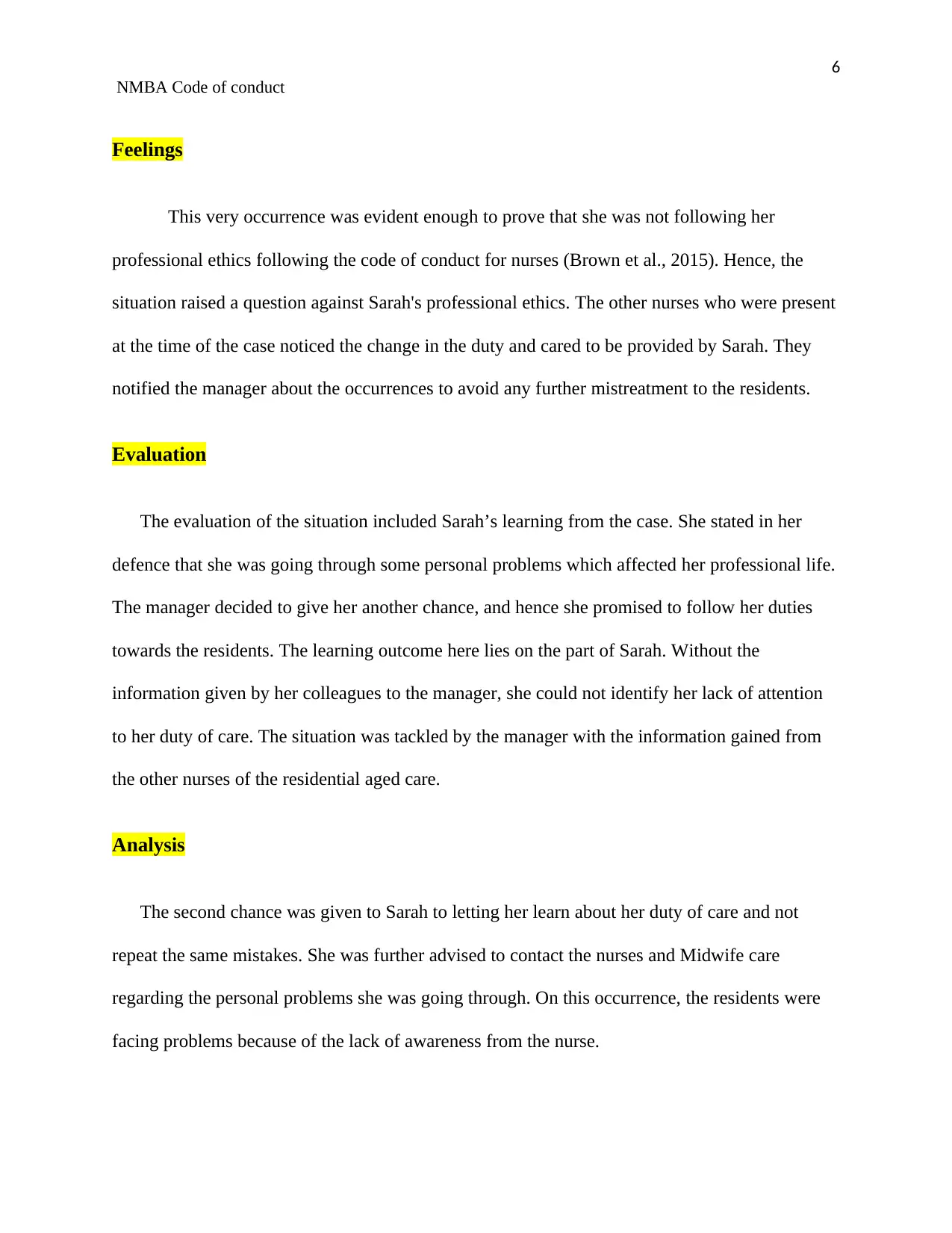
6
NMBA Code of conduct
Feelings
This very occurrence was evident enough to prove that she was not following her
professional ethics following the code of conduct for nurses (Brown et al., 2015). Hence, the
situation raised a question against Sarah's professional ethics. The other nurses who were present
at the time of the case noticed the change in the duty and cared to be provided by Sarah. They
notified the manager about the occurrences to avoid any further mistreatment to the residents.
Evaluation
The evaluation of the situation included Sarah’s learning from the case. She stated in her
defence that she was going through some personal problems which affected her professional life.
The manager decided to give her another chance, and hence she promised to follow her duties
towards the residents. The learning outcome here lies on the part of Sarah. Without the
information given by her colleagues to the manager, she could not identify her lack of attention
to her duty of care. The situation was tackled by the manager with the information gained from
the other nurses of the residential aged care.
Analysis
The second chance was given to Sarah to letting her learn about her duty of care and not
repeat the same mistakes. She was further advised to contact the nurses and Midwife care
regarding the personal problems she was going through. On this occurrence, the residents were
facing problems because of the lack of awareness from the nurse.
NMBA Code of conduct
Feelings
This very occurrence was evident enough to prove that she was not following her
professional ethics following the code of conduct for nurses (Brown et al., 2015). Hence, the
situation raised a question against Sarah's professional ethics. The other nurses who were present
at the time of the case noticed the change in the duty and cared to be provided by Sarah. They
notified the manager about the occurrences to avoid any further mistreatment to the residents.
Evaluation
The evaluation of the situation included Sarah’s learning from the case. She stated in her
defence that she was going through some personal problems which affected her professional life.
The manager decided to give her another chance, and hence she promised to follow her duties
towards the residents. The learning outcome here lies on the part of Sarah. Without the
information given by her colleagues to the manager, she could not identify her lack of attention
to her duty of care. The situation was tackled by the manager with the information gained from
the other nurses of the residential aged care.
Analysis
The second chance was given to Sarah to letting her learn about her duty of care and not
repeat the same mistakes. She was further advised to contact the nurses and Midwife care
regarding the personal problems she was going through. On this occurrence, the residents were
facing problems because of the lack of awareness from the nurse.
⊘ This is a preview!⊘
Do you want full access?
Subscribe today to unlock all pages.

Trusted by 1+ million students worldwide
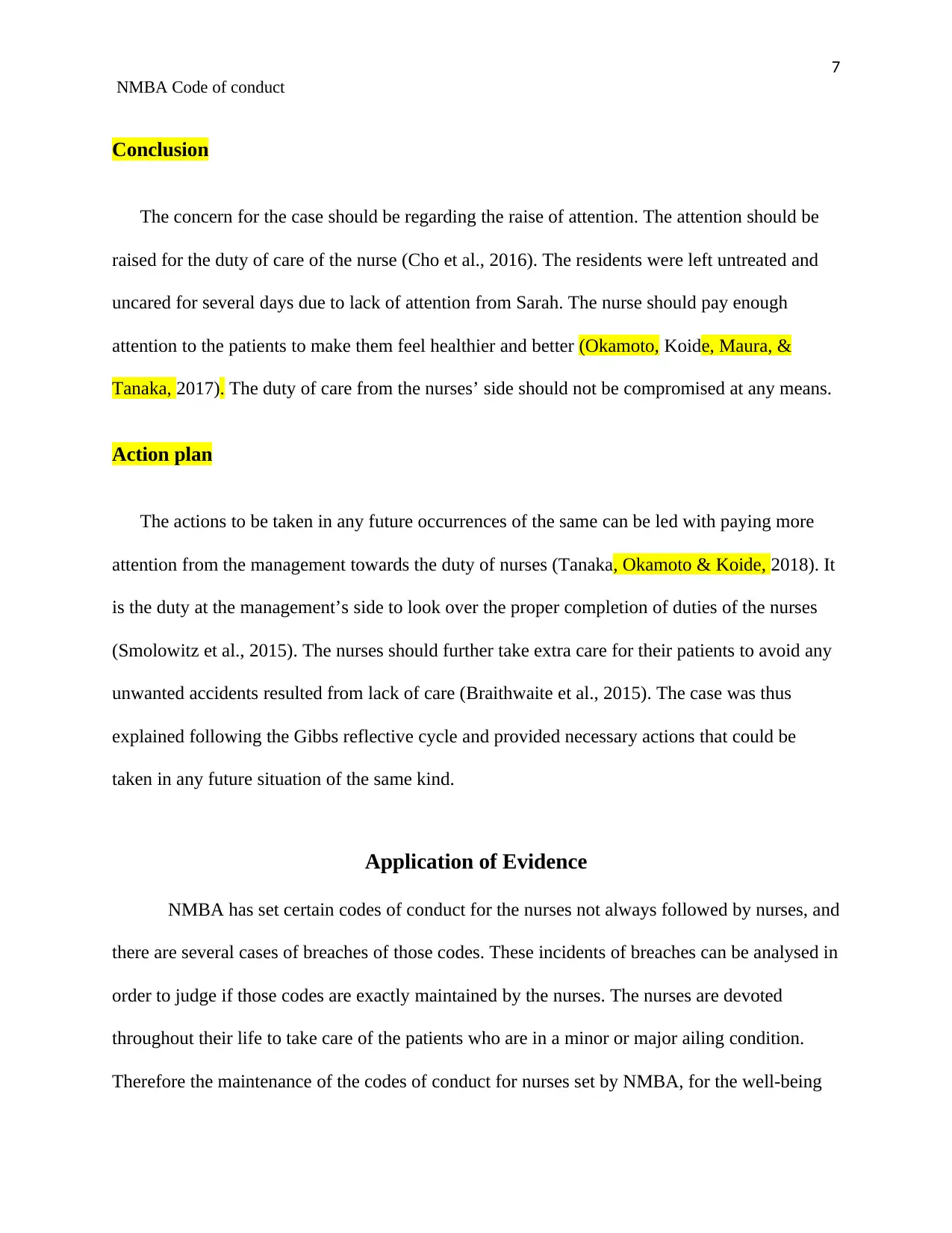
7
NMBA Code of conduct
Conclusion
The concern for the case should be regarding the raise of attention. The attention should be
raised for the duty of care of the nurse (Cho et al., 2016). The residents were left untreated and
uncared for several days due to lack of attention from Sarah. The nurse should pay enough
attention to the patients to make them feel healthier and better (Okamoto, Koide, Maura, &
Tanaka, 2017). The duty of care from the nurses’ side should not be compromised at any means.
Action plan
The actions to be taken in any future occurrences of the same can be led with paying more
attention from the management towards the duty of nurses (Tanaka, Okamoto & Koide, 2018). It
is the duty at the management’s side to look over the proper completion of duties of the nurses
(Smolowitz et al., 2015). The nurses should further take extra care for their patients to avoid any
unwanted accidents resulted from lack of care (Braithwaite et al., 2015). The case was thus
explained following the Gibbs reflective cycle and provided necessary actions that could be
taken in any future situation of the same kind.
Application of Evidence
NMBA has set certain codes of conduct for the nurses not always followed by nurses, and
there are several cases of breaches of those codes. These incidents of breaches can be analysed in
order to judge if those codes are exactly maintained by the nurses. The nurses are devoted
throughout their life to take care of the patients who are in a minor or major ailing condition.
Therefore the maintenance of the codes of conduct for nurses set by NMBA, for the well-being
NMBA Code of conduct
Conclusion
The concern for the case should be regarding the raise of attention. The attention should be
raised for the duty of care of the nurse (Cho et al., 2016). The residents were left untreated and
uncared for several days due to lack of attention from Sarah. The nurse should pay enough
attention to the patients to make them feel healthier and better (Okamoto, Koide, Maura, &
Tanaka, 2017). The duty of care from the nurses’ side should not be compromised at any means.
Action plan
The actions to be taken in any future occurrences of the same can be led with paying more
attention from the management towards the duty of nurses (Tanaka, Okamoto & Koide, 2018). It
is the duty at the management’s side to look over the proper completion of duties of the nurses
(Smolowitz et al., 2015). The nurses should further take extra care for their patients to avoid any
unwanted accidents resulted from lack of care (Braithwaite et al., 2015). The case was thus
explained following the Gibbs reflective cycle and provided necessary actions that could be
taken in any future situation of the same kind.
Application of Evidence
NMBA has set certain codes of conduct for the nurses not always followed by nurses, and
there are several cases of breaches of those codes. These incidents of breaches can be analysed in
order to judge if those codes are exactly maintained by the nurses. The nurses are devoted
throughout their life to take care of the patients who are in a minor or major ailing condition.
Therefore the maintenance of the codes of conduct for nurses set by NMBA, for the well-being
Paraphrase This Document
Need a fresh take? Get an instant paraphrase of this document with our AI Paraphraser
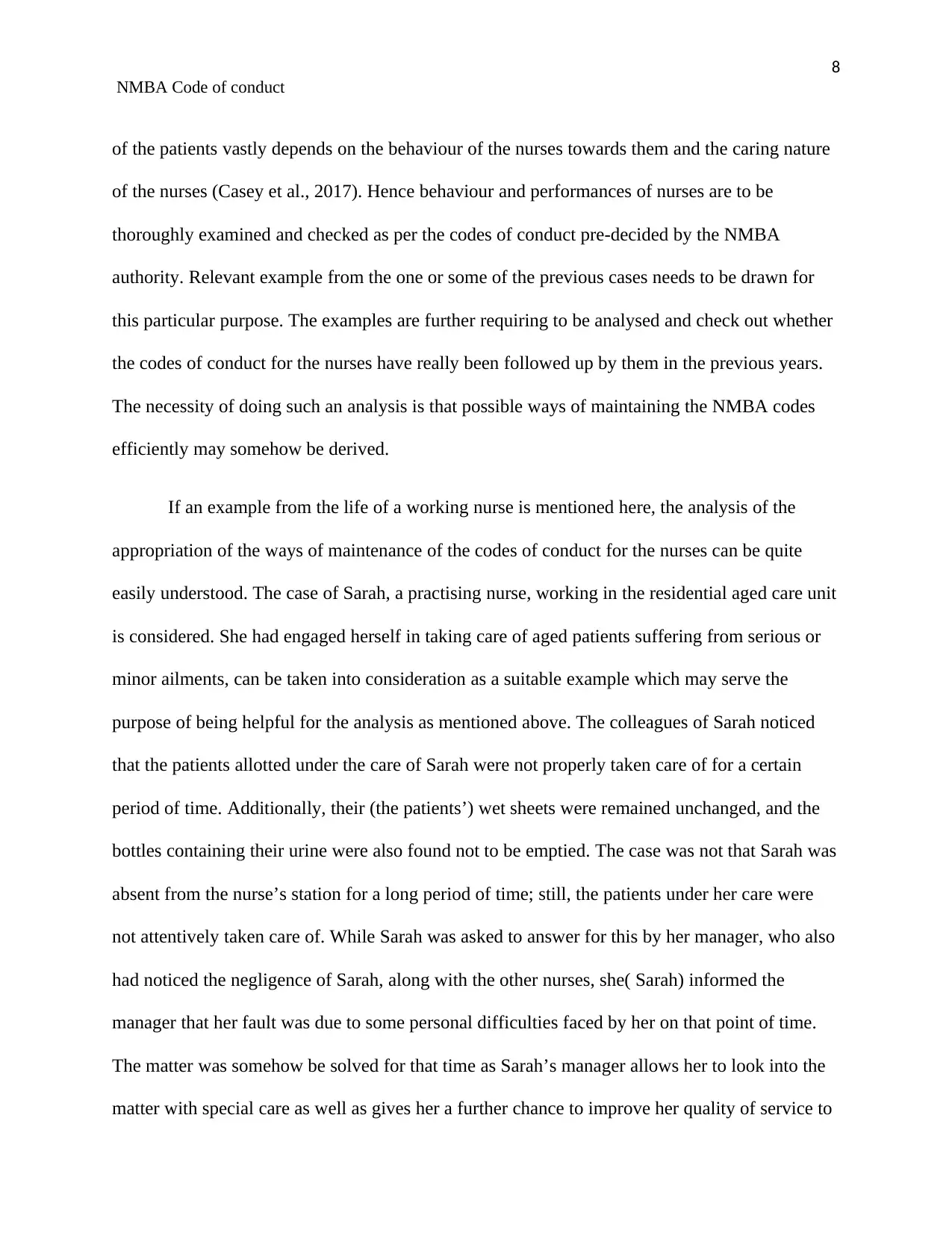
8
NMBA Code of conduct
of the patients vastly depends on the behaviour of the nurses towards them and the caring nature
of the nurses (Casey et al., 2017). Hence behaviour and performances of nurses are to be
thoroughly examined and checked as per the codes of conduct pre-decided by the NMBA
authority. Relevant example from the one or some of the previous cases needs to be drawn for
this particular purpose. The examples are further requiring to be analysed and check out whether
the codes of conduct for the nurses have really been followed up by them in the previous years.
The necessity of doing such an analysis is that possible ways of maintaining the NMBA codes
efficiently may somehow be derived.
If an example from the life of a working nurse is mentioned here, the analysis of the
appropriation of the ways of maintenance of the codes of conduct for the nurses can be quite
easily understood. The case of Sarah, a practising nurse, working in the residential aged care unit
is considered. She had engaged herself in taking care of aged patients suffering from serious or
minor ailments, can be taken into consideration as a suitable example which may serve the
purpose of being helpful for the analysis as mentioned above. The colleagues of Sarah noticed
that the patients allotted under the care of Sarah were not properly taken care of for a certain
period of time. Additionally, their (the patients’) wet sheets were remained unchanged, and the
bottles containing their urine were also found not to be emptied. The case was not that Sarah was
absent from the nurse’s station for a long period of time; still, the patients under her care were
not attentively taken care of. While Sarah was asked to answer for this by her manager, who also
had noticed the negligence of Sarah, along with the other nurses, she( Sarah) informed the
manager that her fault was due to some personal difficulties faced by her on that point of time.
The matter was somehow be solved for that time as Sarah’s manager allows her to look into the
matter with special care as well as gives her a further chance to improve her quality of service to
NMBA Code of conduct
of the patients vastly depends on the behaviour of the nurses towards them and the caring nature
of the nurses (Casey et al., 2017). Hence behaviour and performances of nurses are to be
thoroughly examined and checked as per the codes of conduct pre-decided by the NMBA
authority. Relevant example from the one or some of the previous cases needs to be drawn for
this particular purpose. The examples are further requiring to be analysed and check out whether
the codes of conduct for the nurses have really been followed up by them in the previous years.
The necessity of doing such an analysis is that possible ways of maintaining the NMBA codes
efficiently may somehow be derived.
If an example from the life of a working nurse is mentioned here, the analysis of the
appropriation of the ways of maintenance of the codes of conduct for the nurses can be quite
easily understood. The case of Sarah, a practising nurse, working in the residential aged care unit
is considered. She had engaged herself in taking care of aged patients suffering from serious or
minor ailments, can be taken into consideration as a suitable example which may serve the
purpose of being helpful for the analysis as mentioned above. The colleagues of Sarah noticed
that the patients allotted under the care of Sarah were not properly taken care of for a certain
period of time. Additionally, their (the patients’) wet sheets were remained unchanged, and the
bottles containing their urine were also found not to be emptied. The case was not that Sarah was
absent from the nurse’s station for a long period of time; still, the patients under her care were
not attentively taken care of. While Sarah was asked to answer for this by her manager, who also
had noticed the negligence of Sarah, along with the other nurses, she( Sarah) informed the
manager that her fault was due to some personal difficulties faced by her on that point of time.
The matter was somehow be solved for that time as Sarah’s manager allows her to look into the
matter with special care as well as gives her a further chance to improve her quality of service to
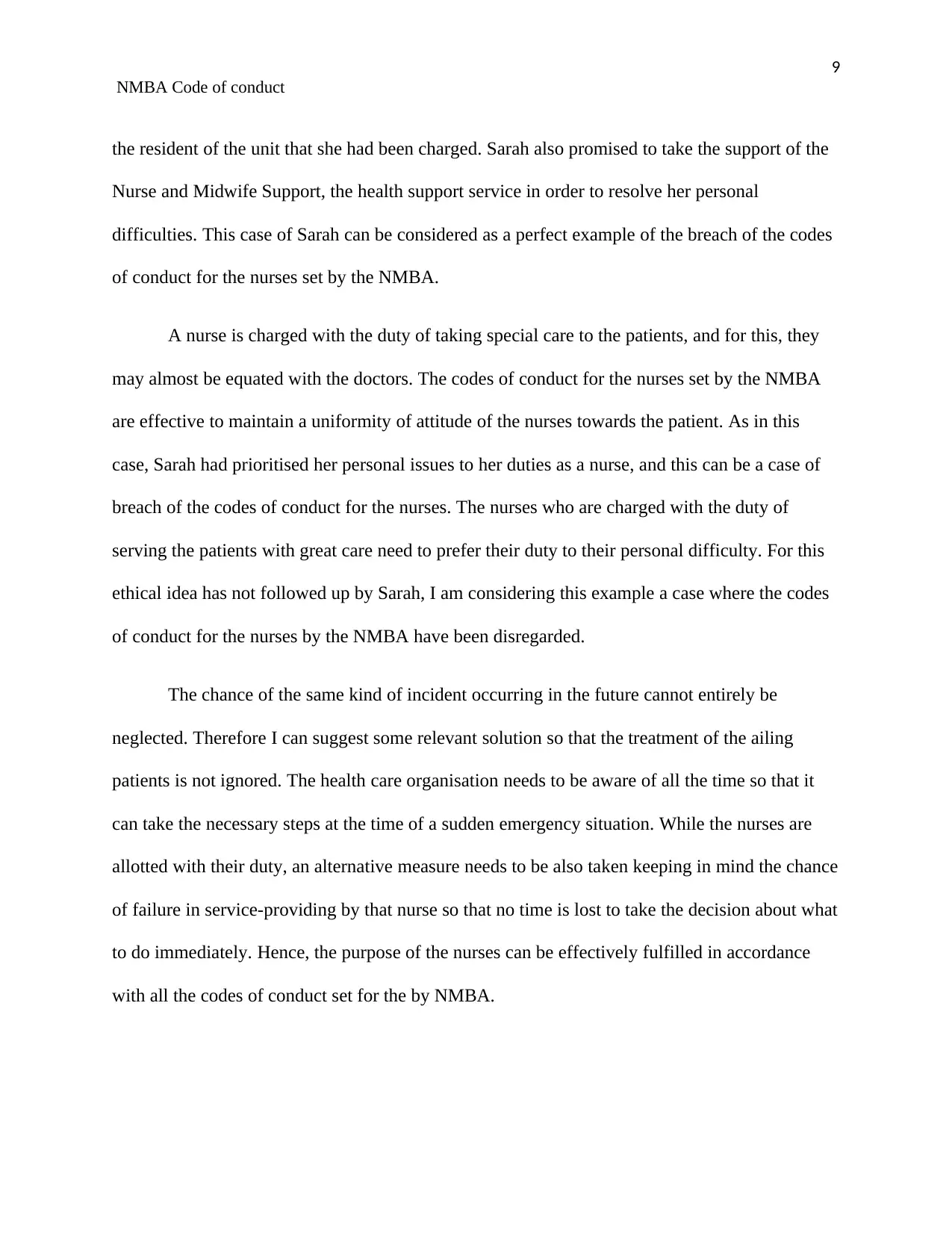
9
NMBA Code of conduct
the resident of the unit that she had been charged. Sarah also promised to take the support of the
Nurse and Midwife Support, the health support service in order to resolve her personal
difficulties. This case of Sarah can be considered as a perfect example of the breach of the codes
of conduct for the nurses set by the NMBA.
A nurse is charged with the duty of taking special care to the patients, and for this, they
may almost be equated with the doctors. The codes of conduct for the nurses set by the NMBA
are effective to maintain a uniformity of attitude of the nurses towards the patient. As in this
case, Sarah had prioritised her personal issues to her duties as a nurse, and this can be a case of
breach of the codes of conduct for the nurses. The nurses who are charged with the duty of
serving the patients with great care need to prefer their duty to their personal difficulty. For this
ethical idea has not followed up by Sarah, I am considering this example a case where the codes
of conduct for the nurses by the NMBA have been disregarded.
The chance of the same kind of incident occurring in the future cannot entirely be
neglected. Therefore I can suggest some relevant solution so that the treatment of the ailing
patients is not ignored. The health care organisation needs to be aware of all the time so that it
can take the necessary steps at the time of a sudden emergency situation. While the nurses are
allotted with their duty, an alternative measure needs to be also taken keeping in mind the chance
of failure in service-providing by that nurse so that no time is lost to take the decision about what
to do immediately. Hence, the purpose of the nurses can be effectively fulfilled in accordance
with all the codes of conduct set for the by NMBA.
NMBA Code of conduct
the resident of the unit that she had been charged. Sarah also promised to take the support of the
Nurse and Midwife Support, the health support service in order to resolve her personal
difficulties. This case of Sarah can be considered as a perfect example of the breach of the codes
of conduct for the nurses set by the NMBA.
A nurse is charged with the duty of taking special care to the patients, and for this, they
may almost be equated with the doctors. The codes of conduct for the nurses set by the NMBA
are effective to maintain a uniformity of attitude of the nurses towards the patient. As in this
case, Sarah had prioritised her personal issues to her duties as a nurse, and this can be a case of
breach of the codes of conduct for the nurses. The nurses who are charged with the duty of
serving the patients with great care need to prefer their duty to their personal difficulty. For this
ethical idea has not followed up by Sarah, I am considering this example a case where the codes
of conduct for the nurses by the NMBA have been disregarded.
The chance of the same kind of incident occurring in the future cannot entirely be
neglected. Therefore I can suggest some relevant solution so that the treatment of the ailing
patients is not ignored. The health care organisation needs to be aware of all the time so that it
can take the necessary steps at the time of a sudden emergency situation. While the nurses are
allotted with their duty, an alternative measure needs to be also taken keeping in mind the chance
of failure in service-providing by that nurse so that no time is lost to take the decision about what
to do immediately. Hence, the purpose of the nurses can be effectively fulfilled in accordance
with all the codes of conduct set for the by NMBA.
⊘ This is a preview!⊘
Do you want full access?
Subscribe today to unlock all pages.

Trusted by 1+ million students worldwide
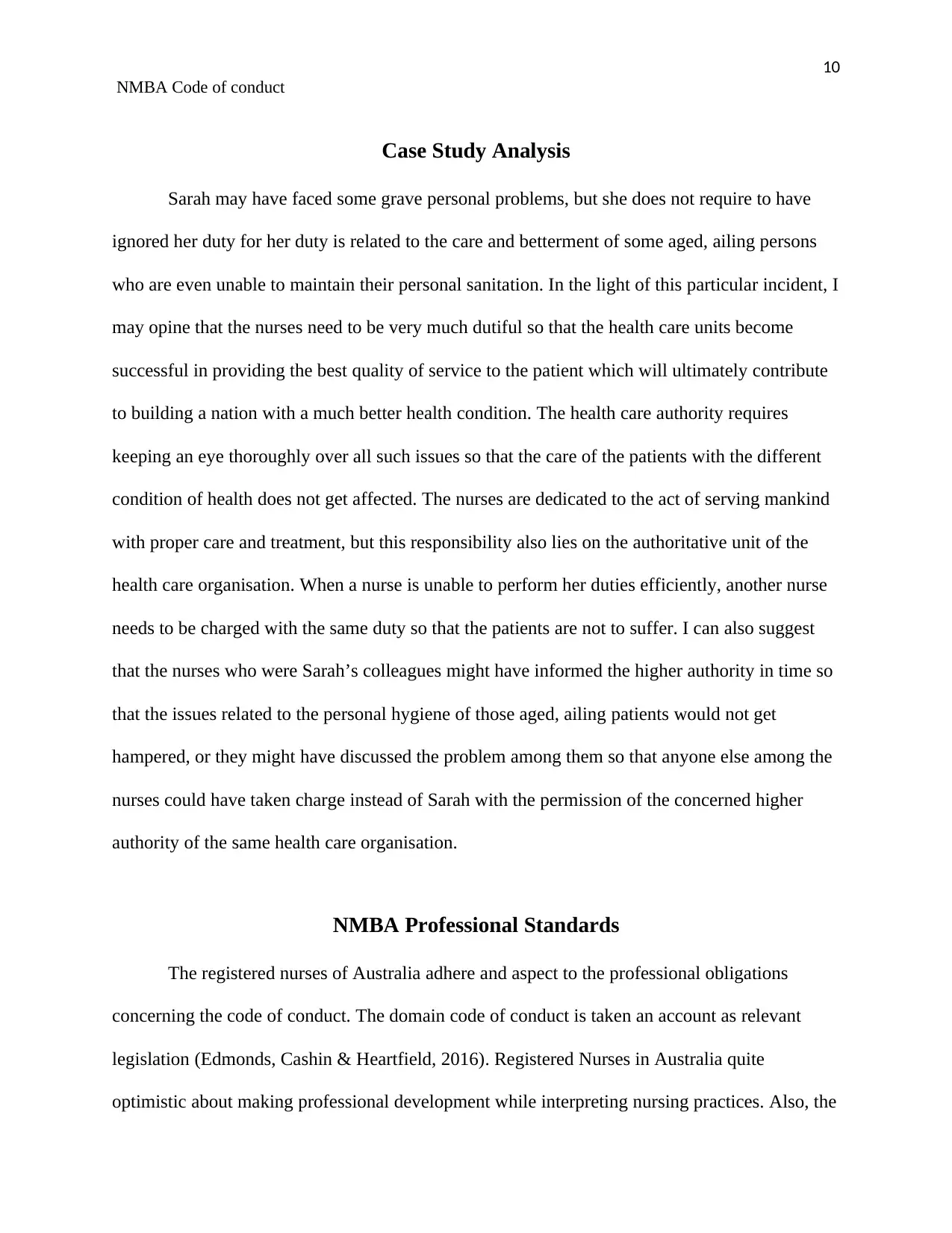
10
NMBA Code of conduct
Case Study Analysis
Sarah may have faced some grave personal problems, but she does not require to have
ignored her duty for her duty is related to the care and betterment of some aged, ailing persons
who are even unable to maintain their personal sanitation. In the light of this particular incident, I
may opine that the nurses need to be very much dutiful so that the health care units become
successful in providing the best quality of service to the patient which will ultimately contribute
to building a nation with a much better health condition. The health care authority requires
keeping an eye thoroughly over all such issues so that the care of the patients with the different
condition of health does not get affected. The nurses are dedicated to the act of serving mankind
with proper care and treatment, but this responsibility also lies on the authoritative unit of the
health care organisation. When a nurse is unable to perform her duties efficiently, another nurse
needs to be charged with the same duty so that the patients are not to suffer. I can also suggest
that the nurses who were Sarah’s colleagues might have informed the higher authority in time so
that the issues related to the personal hygiene of those aged, ailing patients would not get
hampered, or they might have discussed the problem among them so that anyone else among the
nurses could have taken charge instead of Sarah with the permission of the concerned higher
authority of the same health care organisation.
NMBA Professional Standards
The registered nurses of Australia adhere and aspect to the professional obligations
concerning the code of conduct. The domain code of conduct is taken an account as relevant
legislation (Edmonds, Cashin & Heartfield, 2016). Registered Nurses in Australia quite
optimistic about making professional development while interpreting nursing practices. Also, the
NMBA Code of conduct
Case Study Analysis
Sarah may have faced some grave personal problems, but she does not require to have
ignored her duty for her duty is related to the care and betterment of some aged, ailing persons
who are even unable to maintain their personal sanitation. In the light of this particular incident, I
may opine that the nurses need to be very much dutiful so that the health care units become
successful in providing the best quality of service to the patient which will ultimately contribute
to building a nation with a much better health condition. The health care authority requires
keeping an eye thoroughly over all such issues so that the care of the patients with the different
condition of health does not get affected. The nurses are dedicated to the act of serving mankind
with proper care and treatment, but this responsibility also lies on the authoritative unit of the
health care organisation. When a nurse is unable to perform her duties efficiently, another nurse
needs to be charged with the same duty so that the patients are not to suffer. I can also suggest
that the nurses who were Sarah’s colleagues might have informed the higher authority in time so
that the issues related to the personal hygiene of those aged, ailing patients would not get
hampered, or they might have discussed the problem among them so that anyone else among the
nurses could have taken charge instead of Sarah with the permission of the concerned higher
authority of the same health care organisation.
NMBA Professional Standards
The registered nurses of Australia adhere and aspect to the professional obligations
concerning the code of conduct. The domain code of conduct is taken an account as relevant
legislation (Edmonds, Cashin & Heartfield, 2016). Registered Nurses in Australia quite
optimistic about making professional development while interpreting nursing practices. Also, the
Paraphrase This Document
Need a fresh take? Get an instant paraphrase of this document with our AI Paraphraser
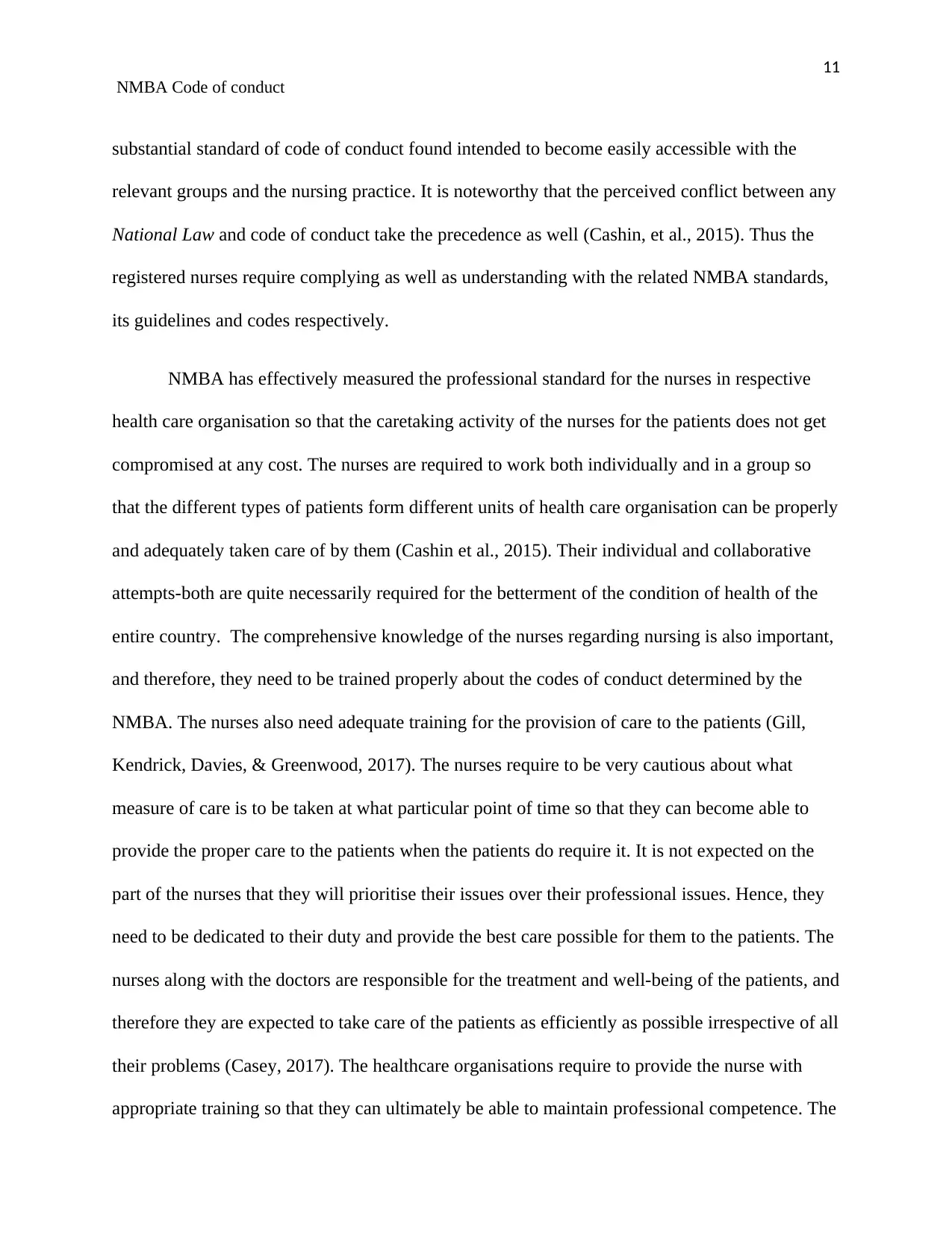
11
NMBA Code of conduct
substantial standard of code of conduct found intended to become easily accessible with the
relevant groups and the nursing practice. It is noteworthy that the perceived conflict between any
National Law and code of conduct take the precedence as well (Cashin, et al., 2015). Thus the
registered nurses require complying as well as understanding with the related NMBA standards,
its guidelines and codes respectively.
NMBA has effectively measured the professional standard for the nurses in respective
health care organisation so that the caretaking activity of the nurses for the patients does not get
compromised at any cost. The nurses are required to work both individually and in a group so
that the different types of patients form different units of health care organisation can be properly
and adequately taken care of by them (Cashin et al., 2015). Their individual and collaborative
attempts-both are quite necessarily required for the betterment of the condition of health of the
entire country. The comprehensive knowledge of the nurses regarding nursing is also important,
and therefore, they need to be trained properly about the codes of conduct determined by the
NMBA. The nurses also need adequate training for the provision of care to the patients (Gill,
Kendrick, Davies, & Greenwood, 2017). The nurses require to be very cautious about what
measure of care is to be taken at what particular point of time so that they can become able to
provide the proper care to the patients when the patients do require it. It is not expected on the
part of the nurses that they will prioritise their issues over their professional issues. Hence, they
need to be dedicated to their duty and provide the best care possible for them to the patients. The
nurses along with the doctors are responsible for the treatment and well-being of the patients, and
therefore they are expected to take care of the patients as efficiently as possible irrespective of all
their problems (Casey, 2017). The healthcare organisations require to provide the nurse with
appropriate training so that they can ultimately be able to maintain professional competence. The
NMBA Code of conduct
substantial standard of code of conduct found intended to become easily accessible with the
relevant groups and the nursing practice. It is noteworthy that the perceived conflict between any
National Law and code of conduct take the precedence as well (Cashin, et al., 2015). Thus the
registered nurses require complying as well as understanding with the related NMBA standards,
its guidelines and codes respectively.
NMBA has effectively measured the professional standard for the nurses in respective
health care organisation so that the caretaking activity of the nurses for the patients does not get
compromised at any cost. The nurses are required to work both individually and in a group so
that the different types of patients form different units of health care organisation can be properly
and adequately taken care of by them (Cashin et al., 2015). Their individual and collaborative
attempts-both are quite necessarily required for the betterment of the condition of health of the
entire country. The comprehensive knowledge of the nurses regarding nursing is also important,
and therefore, they need to be trained properly about the codes of conduct determined by the
NMBA. The nurses also need adequate training for the provision of care to the patients (Gill,
Kendrick, Davies, & Greenwood, 2017). The nurses require to be very cautious about what
measure of care is to be taken at what particular point of time so that they can become able to
provide the proper care to the patients when the patients do require it. It is not expected on the
part of the nurses that they will prioritise their issues over their professional issues. Hence, they
need to be dedicated to their duty and provide the best care possible for them to the patients. The
nurses along with the doctors are responsible for the treatment and well-being of the patients, and
therefore they are expected to take care of the patients as efficiently as possible irrespective of all
their problems (Casey, 2017). The healthcare organisations require to provide the nurse with
appropriate training so that they can ultimately be able to maintain professional competence. The
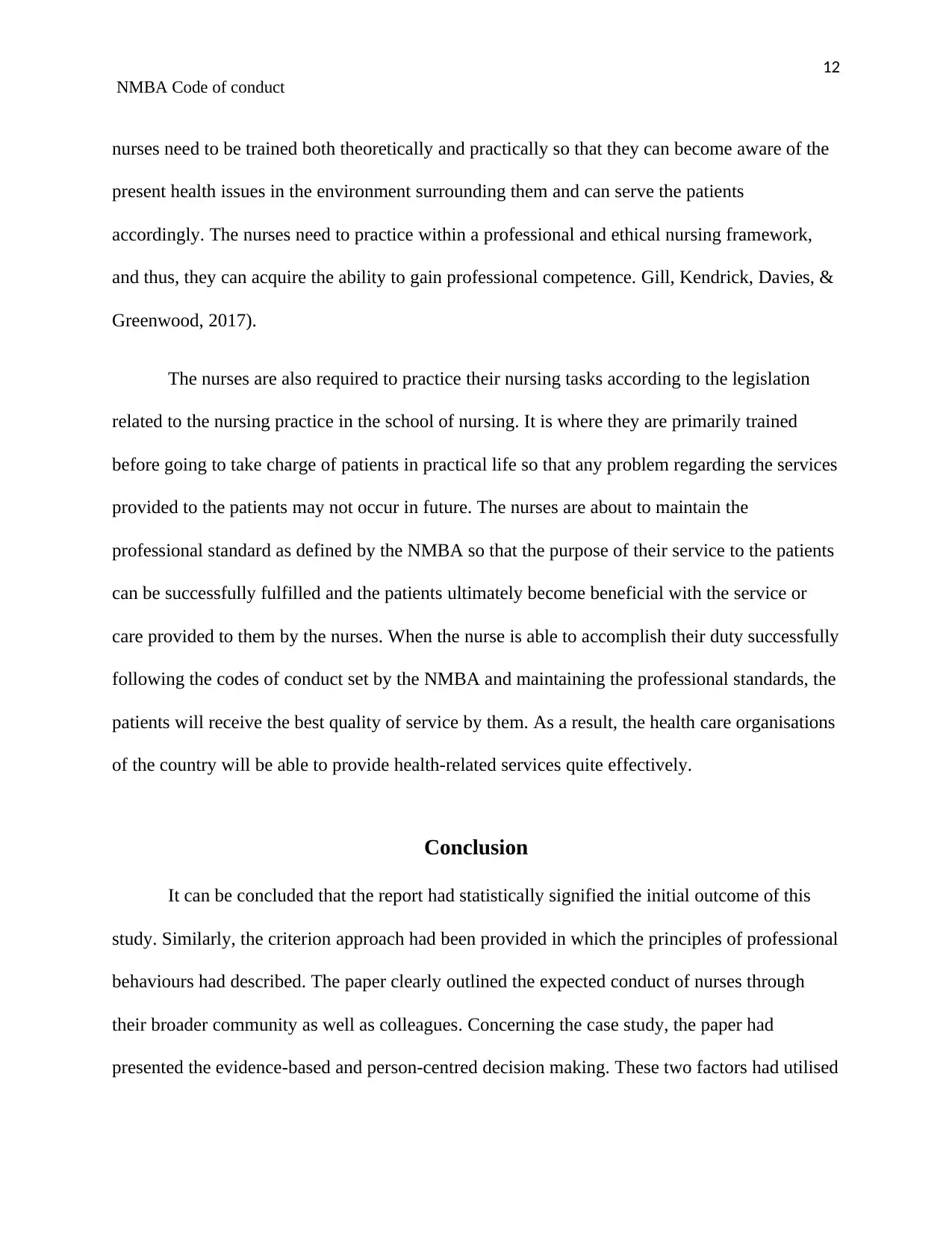
12
NMBA Code of conduct
nurses need to be trained both theoretically and practically so that they can become aware of the
present health issues in the environment surrounding them and can serve the patients
accordingly. The nurses need to practice within a professional and ethical nursing framework,
and thus, they can acquire the ability to gain professional competence. Gill, Kendrick, Davies, &
Greenwood, 2017).
The nurses are also required to practice their nursing tasks according to the legislation
related to the nursing practice in the school of nursing. It is where they are primarily trained
before going to take charge of patients in practical life so that any problem regarding the services
provided to the patients may not occur in future. The nurses are about to maintain the
professional standard as defined by the NMBA so that the purpose of their service to the patients
can be successfully fulfilled and the patients ultimately become beneficial with the service or
care provided to them by the nurses. When the nurse is able to accomplish their duty successfully
following the codes of conduct set by the NMBA and maintaining the professional standards, the
patients will receive the best quality of service by them. As a result, the health care organisations
of the country will be able to provide health-related services quite effectively.
Conclusion
It can be concluded that the report had statistically signified the initial outcome of this
study. Similarly, the criterion approach had been provided in which the principles of professional
behaviours had described. The paper clearly outlined the expected conduct of nurses through
their broader community as well as colleagues. Concerning the case study, the paper had
presented the evidence-based and person-centred decision making. These two factors had utilised
NMBA Code of conduct
nurses need to be trained both theoretically and practically so that they can become aware of the
present health issues in the environment surrounding them and can serve the patients
accordingly. The nurses need to practice within a professional and ethical nursing framework,
and thus, they can acquire the ability to gain professional competence. Gill, Kendrick, Davies, &
Greenwood, 2017).
The nurses are also required to practice their nursing tasks according to the legislation
related to the nursing practice in the school of nursing. It is where they are primarily trained
before going to take charge of patients in practical life so that any problem regarding the services
provided to the patients may not occur in future. The nurses are about to maintain the
professional standard as defined by the NMBA so that the purpose of their service to the patients
can be successfully fulfilled and the patients ultimately become beneficial with the service or
care provided to them by the nurses. When the nurse is able to accomplish their duty successfully
following the codes of conduct set by the NMBA and maintaining the professional standards, the
patients will receive the best quality of service by them. As a result, the health care organisations
of the country will be able to provide health-related services quite effectively.
Conclusion
It can be concluded that the report had statistically signified the initial outcome of this
study. Similarly, the criterion approach had been provided in which the principles of professional
behaviours had described. The paper clearly outlined the expected conduct of nurses through
their broader community as well as colleagues. Concerning the case study, the paper had
presented the evidence-based and person-centred decision making. These two factors had utilised
⊘ This is a preview!⊘
Do you want full access?
Subscribe today to unlock all pages.

Trusted by 1+ million students worldwide
1 out of 17
Related Documents
Your All-in-One AI-Powered Toolkit for Academic Success.
+13062052269
info@desklib.com
Available 24*7 on WhatsApp / Email
![[object Object]](/_next/static/media/star-bottom.7253800d.svg)
Unlock your academic potential
Copyright © 2020–2025 A2Z Services. All Rights Reserved. Developed and managed by ZUCOL.





